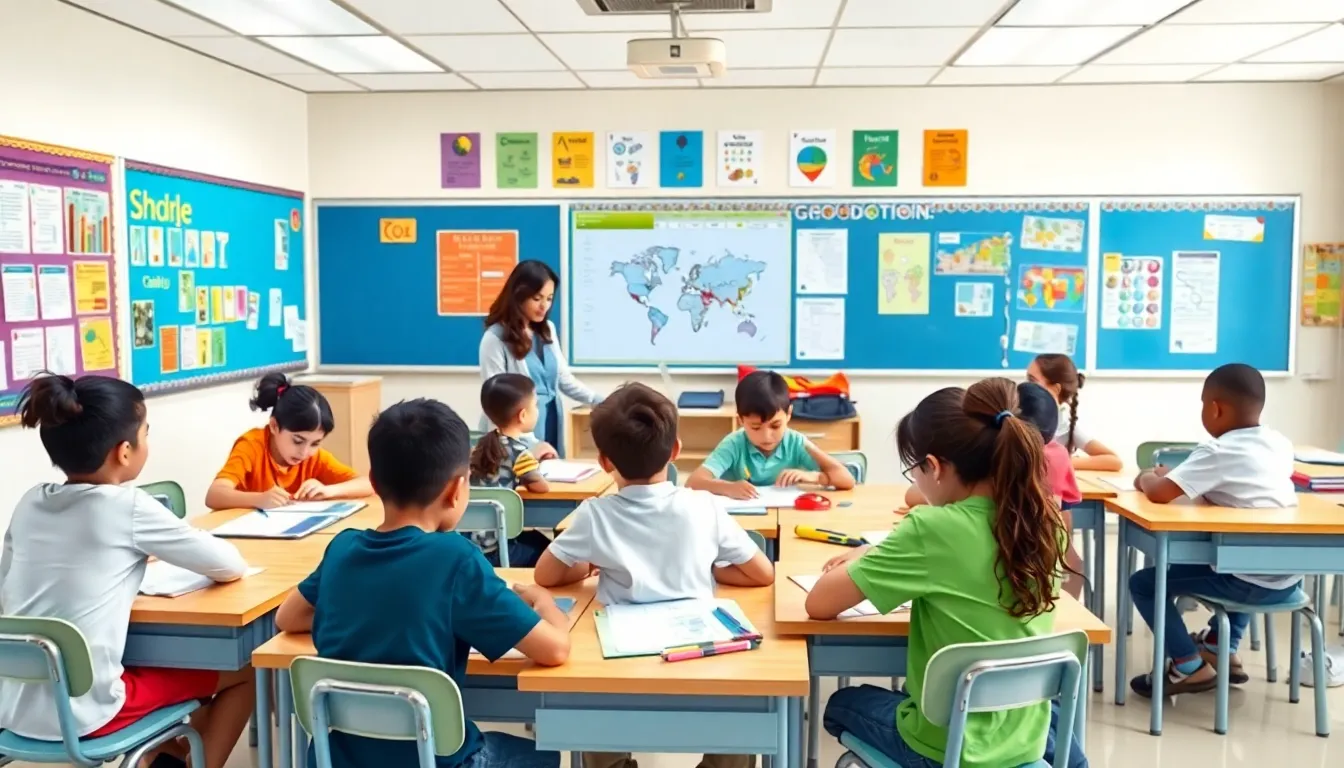When it comes to education, some states seem to be playing a game of dodgeball with academic achievement—and unfortunately, the kids are the ones getting hit. While some states shine like a beacon of knowledge, others can feel more like a black hole of educational opportunity. It’s a wild ride through the K-12 landscape, and not in a good way.
In this article, we’ll take a humorous yet eye-opening look at the worst states for education. From crumbling classrooms to test scores that make you question reality, these states have earned their dubious distinction. Buckle up as we explore the pitfalls of education in these areas, because who knew learning could be such a rollercoaster?
Table of Contents
ToggleOverview of K-12 Education in the United States
K-12 education in the United States varies significantly across states. Disparities in funding, resources, and policies contribute to unequal educational experiences. Some states invest heavily in their school systems, resulting in higher graduation rates and better student performance. Conversely, other states struggle with inadequate funding, leading to overcrowded classrooms and outdated materials.
Data from the National Center for Education Statistics indicates a concerning trend. For instance, 20% of students in low-performing states score below the basic level on standardized tests. These students often lack access to crucial educational resources, such as experienced teachers and advanced courses.
Classroom conditions also influence the overall educational atmosphere. Many states with poor educational outcomes face significant issues like crumbling facilities and limited extracurricular activities. Inadequate support for teachers complicates the situation further, making retention a constant challenge.
As state budgets fluctuate, the impact on K-12 education becomes evident. Budget cuts often lead to staff reductions and program eliminations, which adversely affect student learning and engagement. A study by the Education Trust emphasizes that equitable funding is pivotal for improving educational equity across states.
Even parental involvement plays a role in student success. States where parents are actively engaged tend to have better educational outcomes. In contrast, low levels of community engagement contribute to a decline in educational quality in underperforming states.
Criteria for Evaluation

Evaluating education quality in states relies on several critical criteria. These factors provide insight into the disparities experienced across K-12 systems.
Academic Performance
Standardized test scores serve as primary indicators of academic performance. Inconsistent results across states reveal troubling trends, with 20% of students in low-performing states scoring below basic levels. Graduation rates and proficiency in core subjects further illustrate where educational systems struggle. Analysis of metrics like the National Assessment of Educational Progress shows significant gaps, highlighting the need for targeted improvements in underperforming areas.
Funding and Resources
Funding levels directly impact the resources available to schools. States allocating sufficient budgets typically see improved educational outcomes. In contrast, underfunded states often grapple with overcrowded classrooms and outdated materials. Reports indicate that these schools may lack access to experienced teachers and advanced courses, exacerbating the educational crisis. Further complicating the situation are budget fluctuations that deprive students of necessary support, amplifying the disparities in educational quality between states.
The Worst States for Education K-12
Some states consistently rank among the lowest for K-12 education quality. Various factors contribute to these rankings, from funding issues to test score performance.
State 1: Analysis and Impact
Mississippi frequently occupies the bottom of educational rankings. Its students often face significant barriers, including outdated facilities and limited access to experienced teachers. The National Assessment of Educational Progress reports that a striking 30% of Mississippi students score below the basic level in reading. Funding inadequacies lead to overcrowded classrooms and insufficient learning materials, exacerbating these challenges.
State 2: Analysis and Impact
New Mexico also struggles with K-12 education quality. Low graduation rates indicate systemic issues, as only 75% of high school students complete their education on time. Test scores reflect this struggle, with 24% of students performing below basic proficiency in math. State funding inadequacies hinder schools from providing necessary resources and programs, leaving many students without essential support.
State 3: Analysis and Impact
Alabama ranks poorly in educational outcomes as well. The state’s classrooms often experience high student-to-teacher ratios, negatively impacting individual attention. Approximately 23% of students score below the basic level on standardized tests, showcasing the urgent need for improvement. Limited funding results in outdated textbooks and insufficient learning tools, contributing to stagnant educational performance across the state.
Common Challenges Faced
Various challenges plague K-12 education in lower-performing states. These obstacles hinder student achievement and limit future opportunities.
Funding Issues
Funding issues lead to significant disparities in educational quality. Many states struggle with inadequate financial resources, causing overcrowded classrooms and poor learning environments. For instance, schools in Mississippi often confront outdated facilities, which negatively impacts student engagement. A report from the National Center for Education Statistics shows that states lacking sufficient funding tend to have lower graduation rates and higher dropout rates. Specific allocations directly influence educational outcomes, with underfunded schools unable to provide necessary resources like textbooks and technology. Consequently, the cycle of educational decline continues, with low investment correlating to low performance.
Teacher Shortages
Teacher shortages create further challenges in these struggling states. States like New Mexico and Alabama frequently report a lack of qualified educators, which exacerbates the quality of instruction. High student-to-teacher ratios often result in teachers being unable to devote individual attention to students. This scarcity leads to burnout among existing educators, further straining the educational system. According to recent data, approximately 30% of teachers in low-performing states report feeling overwhelmed. The absence of experienced teachers stymies students’ academic progress, reinforcing systemic inequalities. Ultimately, addressing these shortages remains crucial for enhancing education quality and ensuring that all students receive a fundamental education.
Potential Solutions
Addressing educational disparities requires focused strategies. Enhancing K-12 education involves several key policy changes and increased community engagement.
Policy Recommendations
Investment in educational funding stands as a critical step. States must prioritize equitable funding formulas that allocate resources based on student needs. Grant programs for underperforming schools often support infrastructure improvements and teacher recruitment, playing a vital role in education quality. Implementing accountability measures promotes transparency, ensuring that funding translates into better student outcomes. Further, incentivizing high-quality teacher training can directly impact classroom effectiveness, boosting academic performance. Emphasizing standardized test results provides data-driven insights to tailor educational improvements.
Community Involvement
Active community involvement is essential for elevating educational quality. Parents, local organizations, and businesses can collaborate to support schools. Community tutoring programs often provide additional academic support for struggling students, enhancing learning outcomes. Increased volunteer opportunities in schools attract engaged parents, directly influencing student success. Organizing local events can foster a stronger connection between the community and schools, encouraging support for initiatives aimed at improvement. Establishing partnerships with businesses often leads to internship and mentorship opportunities, offering real-world experiences that can inspire students.
The state of K-12 education in the United States presents a stark contrast between those that thrive and those that struggle. The challenges faced by states like Mississippi, New Mexico, and Alabama highlight the urgent need for systemic change. Poor funding, overcrowded classrooms, and inadequate resources create environments where students cannot succeed.
Addressing these issues requires collaboration among policymakers, educators, and communities. By prioritizing equitable funding and enhancing community engagement, there’s potential for significant improvement. The future of education in these struggling states depends on collective efforts to ensure every student has access to a quality education, paving the way for brighter opportunities ahead.




